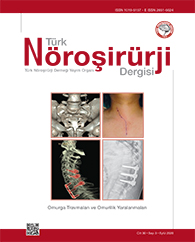Türk Nöroşirürji Dergisi
2020 , Vol 30 , Num 3
Introduction to Thoracolumbar Spine Injury: Epidemiology, Injury Mechanism, Classifications, and Evaluation of Instability
1Sağlık Bilimleri Üniversitesi Ankara Eğitim ve Araştırma Hastanesi, Nöroşirürji Kliniği, Ankara, Türkiye
Blunt trauma is a leading cause of mortality and morbidity in industrialized and developing countries. Although fractures of the
spine occur only in a small proportion of blunt trauma patients, they often have serious consequences on the social, economical
and medical status of the patient. The incidence of post traumatic spinal column injuries compared to all bone fractures is reported
4-23%. Thoracolumbar vertebral fractures are seen in 96% of spinal fractures and are usually located in the thoracolumbar junction
as it is the transition zone. Spinal fractures, which usually occur as a result of high-energy traumas in young people, may also be
the result of lower-energy traumas due to osteoporosis and aging spine in the elderly population. In the past, classification systems
defined 2 or 3 column stability and the mechanism of injury. However, recent classification systems discuss the integrity of the
posterior ligamentous complex, define the morphology of the injury, and evaluate the neurological condition and status of the
patient. The ideal classification should be relatively simple and facilitate choosing the management and treatment options.
Anahtar Kelimeler :
Thoracolumbar trauma, Classifying, Epidemiology, Thoracolumbar fractures

